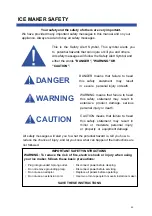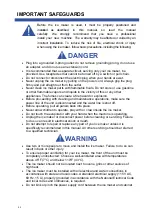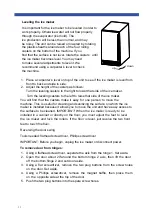
•
This ice maker should be properly installed by qualified personnel.
•
To ensure proper ventilation for your ice maker, the front of the unit
must be completely unobstructed.
•
Choose a well ventilated area with temperatures above 45°F (7°C) and
below 110°F (43°C).
•
The unit should not be located next to ovens, grills or other high heat sources.
•
Installation of the ice maker requires a cold water supply inlet of ¼-in.
(6.35mm) soft copper tubing with a shut-off valve.
•
The ice maker requires a continuous water supply with a minimum pressure of
15 psig and a static pressure not to exceed 80 psig. The temperature of the
water feeding into the ice maker should be between 41°F (5°C) and 90°F (32°
C) for proper operation.
•
It is strongly recommended that a water filter be used.
A filter, if it is
of the proper type, can remove taste and odors as well as particles. Some
water is very hard, and softened water may result in white, mushy cubes
that stick together. Deionized water is not recommended.
•
The ice maker must be installed with electrical and water connections in
accordance with all state and local codes.
•
The unit should be located on a firm and level surface. It is important for the ice
maker to be leveled in order to work properly.
If needed, you can adjust the
height of the ice maker by revolving the caster. See the
Leveling the Ice Maker
section.
•
A standard electrical supply (115V AC only, 60Hz, 15A), properly
grounded in accordance with the National Electrical Code and local
codes and ordinances, is required.
IMPORTANT: Do not kink or pinch the power supply cord between the icemaker
and wall or cabinet.
Normal operating ambient temperature should be between 45°F (7°C)
to 110°F (43°C). Normal operating water temperature should be
between 41°F (5°C) and 90°F (32°C). Operation of the ice maker for
extended periods outside of these normal temperature ranges may
affect production capacity.
WARNING
0
9














































